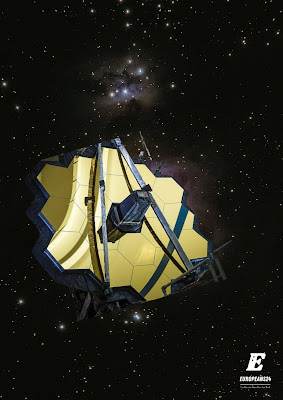The James Webb telescope, which was launched this Saturday at midday by an Ariane 5 rocket, has been one of NASA’s most ambitious undertakings since the turn of the century.
The James Webb telescope, which will be launched this Saturday at midday by an Ariane 5 rocket, has been one of NASA’s most ambitious undertakings since the turn of the century. The space observatory will be tasked with traveling back in time 13.5 billion years.
” From where do we come? This is probably one of the most perplexing questions that humanity has ever faced. It was transformed into a mission order for NASA’s new gem. Unless there is a last-minute change, the James Webb Space Telescope (JWST) will launch from Kourou on Saturday at 1:20 p.m. Paris time on an Ariane 5 rocket.
The telescope, the result of a collaboration between American, European, and Canadian authorities, is a time machine, designated as the successor to the iconic Hubble – and even more so at the less famous Spitzer. It can collect the light produced by very distant and very ancient sources by conducting observations in the medium infrared. He’ll have to monitor “the faint signals of the universe’s very first galaxies” 13.5 billion years ago, “a few hundred million years after the Big Bang.”
-235° C
NASA and its allies have thought big, very large, to complete such a project. The JWST’s proportions are equivalent to those of a tennis court. Its weight is comparable to that of a bus. Its primary mirror is about three times the size of Hubble’s, measuring over 6 meters in diameter.
According to the US space agency, it is “the biggest and most powerful telescope ever built.” […] It is so sensitive that it could possibly identify the thermal signature of a drone flying at a distance equal to the distance between the Earth and the Moon.
Such objectives have necessitated overcoming enormous technical obstacles. The initial step was to create a collapsible gadget that could fit inside Ariadne’s fairing, which is why the JWST was created “like an origami” and will unfurl once in orbit. The second step was to cool it sufficiently so that its infrared sensors were not obscured by its own heat.
James Webb will evolve at a temperature of roughly – 235 ° C under the protection of his solar shield, which consists of five layers of polymers as thin as a hair. A cryogenic cooling system will further reduce the thermometers of key equipment to -266 ° C, which is close to “absolute zero.”
The telescope that ate astronomy
The JWST nearly never saw the light of day due to its technological complexity. When it was first announced in the late 1990s, the initiative was supposed to debut in 2007 at a cost of less than a billion dollars. These blueprints were turned upside down due to design and assembly issues. Its development was not confirmed until 2008, with a revised timetable set for 2014 and an estimated cost of $5 billion. Since then, the timeline has slipped further, and the bill has more than quadrupled to $ 9.7 billion.
James Webb ate up so much money that the magazine “Nature” called him “the telescope that devoured astronomy” in 2010. “The space observatory promises to open new windows on the cosmos, but its expense may force many others to close,” stated the scientific publication, which was concerned about the funding of other studies. An argument taken up in 2011 by a committee of the American House of Representatives, which urged its cancellation, blaming the project’s “disastrous management.” A stance that was eventually rejected by Congress.
The value of the JWST is way too high. Many scientific initiatives are only waiting for their initial photos to begin operation. Failure is not an option, as it would mean thrusting astrophysicists into the unknown. It will take a month after launch to reach its goal, 1.5 million kilometers from our planet, or almost four times the Earth-Moon distance. It will take roughly five months to align its mirrors and calibrate its equipment. The first findings are due next summer.








+ There are no comments
Add yours